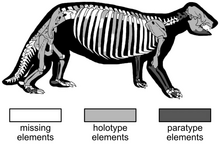| Parocnus Temporal range:
| |
|---|---|

| |
| Skeleton of Parocnus dominicanus | |
| Scientific classification | |
| Domain: | Eukaryota |
| Kingdom: | Animalia |
| Phylum: | Chordata |
| Class: | Mammalia |
| Order: | Pilosa |
| Family: | †Megalocnidae |
| Genus: | †Parocnus Miller 1929 |
| Species | |
|
See text | |

Parocnus is an extinct genus of sloth native to Cuba and Hispaniola, belonging to the family Megalocnidae. It was a terrestrial ground sloth, being the second largest Caribbean sloth after Megalocnus.[1]
Taxonomy[edit]
After[2]
- †Parocnus browni Pleistocene to Holocene, Cuba
- †Parocnus serus Pleistocene to Holocene, Hispaniola (synonym Megalocnus zile)[1]
- †Parocnus dominicanus Pleistocene to Holocene, Hispaniola[3]
References[edit]
- ^ a b McAfee, Robert K.; Beery, Sophia M. (2021-03-04). "Intraspecific variation of Megalonychid sloths from Hispaniola and the taxonomic implications". Historical Biology. 33 (3): 371–386. Bibcode:2021HBio...33..371M. doi:10.1080/08912963.2019.1618294. ISSN 0891-2963. S2CID 195403443.
- ^ White, J.L.; MacPhee, R.D.E. (2001). "The sloths of the West Indies: a systematic and phylogenetic review". In Woods, C. A.; Sergile, F. E. (eds.). Biogeography of the West Indies: Patterns and Perspectives. Boca Raton, London, New York, and Washington, D.C.: CRC Press. pp. 201–235. doi:10.1201/9781420039481-14. ISBN 978-0-8493-2001-9.
- ^ McAfee, Robert; Beery, Sophia; Rimoli, Renato; Almonte, Juan; Lehman, Phillip; Cooke, Siobhan (2021-08-31). "New species of the ground sloth Parocnus from the late Pleistocene-early Holocene of Hispaniola". Vertebrate Anatomy Morphology Palaeontology. 9 (1). doi:10.18435/vamp29369. ISSN 2292-1389.


Well, that’s interesting to know that Psilotum nudum are known as whisk ferns. Psilotum nudum is the commoner species of the two. While the P. flaccidum is a rare species and is found in the tropical islands. Both the species are usually epiphytic in habit and grow upon tree ferns. These species may also be terrestrial and grow in humus or in the crevices of the rocks.
View the detailed Guide of Psilotum nudum: Detailed Study Of Psilotum Nudum (Whisk Fern), Classification, Anatomy, Reproduction